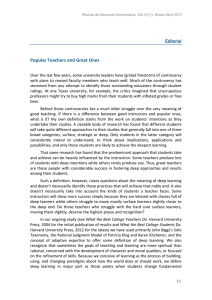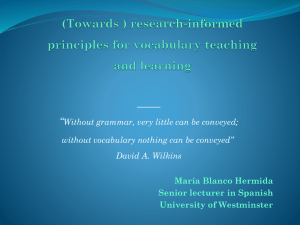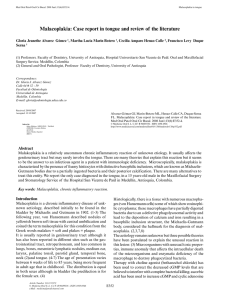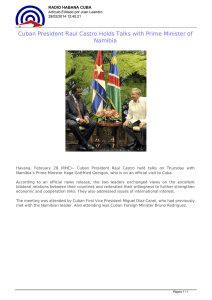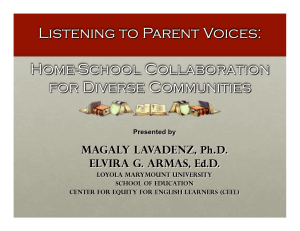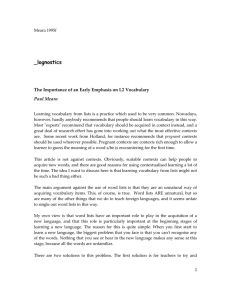Reflections on the question of mother tongue instruction in Namibia
Anuncio
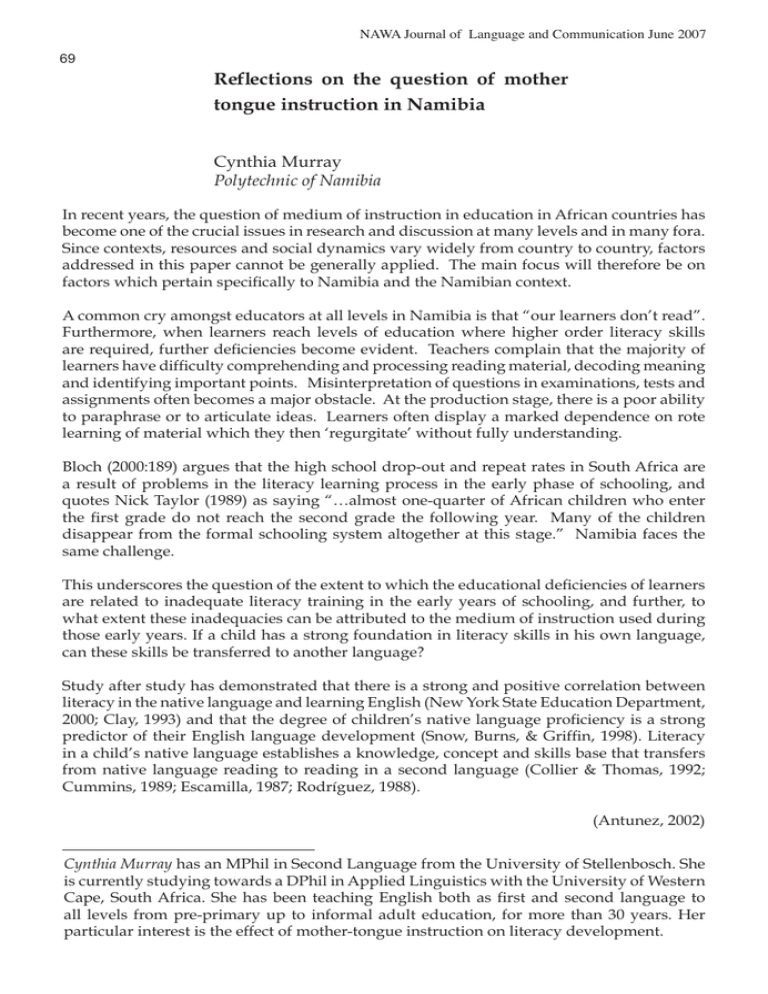
NAWA Journal of Language and Communication June 2007 69 Reflections on the question of mother tongue instruction in Namibia Cynthia Murray Polytechnic of Namibia In recent years, the question of medium of instruction in education in African countries has become one of the crucial issues in research and discussion at many levels and in many fora. Since contexts, resources and social dynamics vary widely from country to country, factors addressed in this paper cannot be generally applied. The main focus will therefore be on factors which pertain specifically to Namibia and the Namibian context. A common cry amongst educators at all levels in Namibia is that “our learners don’t read”. Furthermore, when learners reach levels of education where higher order literacy skills are required, further deficiencies become evident. Teachers complain that the majority of learners have difficulty comprehending and processing reading material, decoding meaning and identifying important points. Misinterpretation of questions in examinations, tests and assignments often becomes a major obstacle. At the production stage, there is a poor ability to paraphrase or to articulate ideas. Learners often display a marked dependence on rote learning of material which they then ‘regurgitate’ without fully understanding. Bloch (2000:189) argues that the high school drop-out and repeat rates in South Africa are a result of problems in the literacy learning process in the early phase of schooling, and quotes Nick Taylor (1989) as saying “…almost one-quarter of African children who enter the first grade do not reach the second grade the following year. Many of the children disappear from the formal schooling system altogether at this stage.” Namibia faces the same challenge. This underscores the question of the extent to which the educational deficiencies of learners are related to inadequate literacy training in the early years of schooling, and further, to what extent these inadequacies can be attributed to the medium of instruction used during those early years. If a child has a strong foundation in literacy skills in his own language, can these skills be transferred to another language? Study after study has demonstrated that there is a strong and positive correlation between literacy in the native language and learning English (New York State Education Department, 2000; Clay, 1993) and that the degree of children’s native language proficiency is a strong predictor of their English language development (Snow, Burns, & Griffin, 1998). Literacy in a child’s native language establishes a knowledge, concept and skills base that transfers from native language reading to reading in a second language (Collier & Thomas, 1992; Cummins, 1989; Escamilla, 1987; Rodríguez, 1988). (Antunez, 2002) Cynthia Murray has an MPhil in Second Language from the University of Stellenbosch. She is currently studying towards a DPhil in Applied Linguistics with the University of Western Cape, South Africa. She has been teaching English both as first and second language to all levels from pre-primary up to informal adult education, for more than 30 years. Her particular interest is the effect of mother-tongue instruction on literacy development. NAWA Journal of Language and Communication June 2007 70 As with other countries in Africa, the issues of language policy and medium of instruction have become the focus of much debate in Namibia. The complexity of the problem of language in education in Namibia becomes apparent when one considers the variety of languages and dialects to be found in the country. Seven different dialects of Oshiwambo are spoken in Namibia: Oshikwanyama, Oshindonga, Oshikolonkadhi, Oshimbalantu, Oshikwaluudhi, Oshingangera and Oshikwambi, but only Oshikwanyama and Oshindonga have standard written forms and are taught as subjects on schools. Other languages spoken in Namibia have been identified by Gordon (2005) as follows: Afrikaans, Diriku, English, Few, Hai||om, Herero, Ju|’hoan, Kung-Ekoka, Kwambi, Kwangali, =|Kx’au||’ein, Kxoe, Lozi, Mashi, Mbalanhu, Mbukushu, Nama, Naro, Subiya, Totela, Tswana, Vasekela, Bushman,!Xóõ Yeyi and Zemba It is this diversity which has complicated the development of a language policy both for the country as a whole, and for education in particular. In the words of former Prime Minister, Hage Geingob, [W]hen SWAPO decided during its struggle for independence to make English the Official Language of Namibia, and when the framers of the Constitution decided to choose English as the Official Language, it was not an ad hoc decision. It was a considered decision. … We live in a world where distances have shrunk, and the global village is a reality. For Namibia, therefore, we had to choose a language that would remove the isolation imposed by the colonisers, which restricted our capacity to communicate with the outside world, restricted our capacity to produce our own literature, our own men of letters. Language in Namibia was taught to the majority with only one objective - to give them instructions at the work-place. Isolation imposed on us, by denying most Namibians education in a global language, seems to have been durable. On Independence, therefore, we had to choose a language that would open up the world to us. English was the obvious choice. After all, English is the most widely spoken language, spoken by some six hundred million people. There is no corner of the globe where you could not get by if you knew English. You could also get by in many countries if you knew French; but we cannot say that about most other languages. (in Chamberlain, Diallo and John 1981:12) In 1991, after lengthy discussions in all regions of Namibia, a policy was agreed on, and was issued in the document Education and Culture in Namibia: The Way Forward to 1996 ((MBESC Discussion Document 2003). Among the criteria which were taken into consideration were • • The fact that for pedagogical reasons it is ideal for learners to study through their mother tongue, particularly in the early years of schooling when basic skills of reading, writing and concept formation are acquired. The need for learners to be proficient enough in English, the official language, at the end of the seven-year primary school cycle in order to gain access to further education as well as to a language of wider communication. In 1992, a specific language policy for schools was implemented, the goals of which included NAWA Journal of Language and Communication June 2007 71 the following (Chamberlain 1993:5): • • • Promotion of a learner’s own language and cultural identity through the use of homelanguage (mother tongue) instruction, at least at the lower primary level. Proficiency in English, the official language, by the end of the seven-year primary cycle. English as the medium of instruction beyond the lower primary level. In the years following the implementation of this policy, a number of obstacles to the effective application of these principles have become apparent, often resulting from practical problems and the reality experienced by educators in the field. These include factors such as the lack of qualified mother-tongue teachers, a belief amongst parents that there are greater benefits for children in being taught through the medium of English, and the perceived lack of status of the indigenous languages. Many of these issues are highlighted in a Language Policy Impact Report presented by Chamberlain in 1993. Writing about the Ondangwa region which is populated by Oshiwambo speakers, Chamberlain noted that learners were well-motivated both to learn English and to learn through English, and that in Grades 1 to 3 in particular, learners who were good at their home language were also good at English. He also noted that primary school learners were usually exposed to English only in the classroom. A further factor mentioned was the lack of confidence of primary grade teachers in using or teaching English due to the fact that they had not been trained in English (Chamberlain 1993:18). In the conclusion to this report, Chamberlain (1993:76) warns against “situations in which children are disadvantaged by being forced to learn through different media of instruction to the detriment of their home language and their understanding of the curriculum.” Research conducted by Trewby in 1999 investigated what choices were being made in Namibia as to medium of instruction in the lower primary grades. This research indicated that certain language groups were more likely to receive mother tongue instruction than others. Trewby suggested five main reasons why this might be so: 1. 2. 3. 4. 5. The school might have such a heterogeneous population that the learners speak too many different languages for one to be chosen as the medium of instruction. The authorities and the community may have decided that it would be fairer if all the children were to learn through the medium of another language, i.e. English or Afrikaans, since the other learners might be disadvantaged if the language of the majority was used. There might be no teachers on the staff of the school who could teach that language. There might be no upper primary or secondary schools where the learners could continue to study their language. The instructional materials for the language may not be as good as those for English or Afrikaans. (Trewby 1999:2) Trewby’s conclusions were supported by the findings of the Presidential Commission on Education Culture and Training which brought to light the following perceptions among informants (which included teachers), who felt that NAWA Journal of Language and Communication June 2007 72 [T]here was inequality in education due to the fact that English was used as the medium of instruction in the southern areas while in the north mother tongue was used for the first three grades. The official language should be used rather than the local language at the lower primary level so that learners could benefit from learning basic terminology in subjects at an early age. English-language competence was undermined by the use of mother-tongue instruction, as shown by the fact that Grade 4 learners performed so poorly. Learners in Grade 4 seem to be in school for the first time. They cannot read, talk, or comprehend English. They cannot pay attention. They lack the necessary vocabulary. The teacher cannot communicate with them and it forces him or her to explain in the mother tongue. There is a communication breakdown between teachers and learners due to the use of the vernacular as the medium of instruction. Learners are unable to express themselves in English while foreign teachers and teachers from other regions, on the other hand, cannot express themselves in the vernacular of that particular place. The teacher loses enthusiasm, which in itself is yet another obstacle facing learners who probably already feel that their language difficulties are overwhelming. The Namibian environment does not create a conducive atmosphere for effective English learning. The basic competencies are not established well enough to implement a second language as a medium of instruction on a formal basis in Grade 4. It is a proven fact that youngsters who have not accomplished the basic competencies in their own mother tongue are unable to think and argue in another language. There is a very big gap which learners cannot overcome when starting fully fledged with English in Grade 4 for the first time. This causes poor results, frustration among learners and teachers, and an increase in the dropout rate. The emphasis on competence in English need not be detrimental to capacity in the mother tongue. (2000:39) Further issues mentioned in the Presidential Commission’s report (2000:109) were that • it was difficult for some multi-cultural communities to implement the language policy in schools. • in areas to the south of Windhoek, there was a tendency to regard Afrikaans as the mother tongue of some learners whereas it was in fact their second language. • parents expressed a preference for English medium instruction, believing the advantages to outweigh the learning difficulties. It is interesting to note that the Presidential Commission cites proposals that English should be the compulsory medium of instruction throughout grades 1 to 12, with local languages being used parallel with English in grades 1, 2 and 3, thus giving equal access to all learners (2000:41). It is not made entirely clear, however, exactly how this principle would be applied, and it appears to be somewhat idealistic. Considering the situation ‘on the ground’ in the majority of Namibian schools, the logistics involved in providing both local languages and English would be monumental. Very few Namibian primary schools have homogenous groups in any grade, let alone the first three grades, so which local language would be chosen for any one group? Add to this the lack of teachers qualified to teach in local languages and the limited availability of teaching material in these languages, and the NAWA Journal of Language and Communication June 2007 73 problem intensifies. In 2000, at the Conference on Language and Development in Southern Africa, problems being experienced with the Language Policy of Namibia were brought to light, and the recommendation was made that the policy be revised. This led to the publication and distribution in 2003 by the then Ministry of Basic Education and Culture of a Discussion Document, which included in its rationale that [e]ducation in the mother tongue, especially in the lower primary cycle of basic education, is crucial for concept formation as well as literacy and numeracy attainment. In order to be literate, one should not only speak well, but also know the written language, as language is the system of human expression by means of words. For people to be in a position to communicate and understand each other this system needs to be fully functional. In the Discussion Document, all recommendations made during the conference were followed, except for that proposing that mother tongue instruction should continue beyond Grade 3, which was rejected because of the financial implications. Resulting changes to the Language Policy for Schools were as follows: • • • The strengthening of mother tongue instruction in Grades I, 2 and 3, through materials development and teacher pre- and in-service training. More emphasis for the mother tongues to be taken as First Language subjects from Grade I through to Grade 12. Emphasis on the fact that the wish by a school, school board and parent community to offer English as medium of instruction from Grade I must receive ministerial approval. Discussing the issue of mother tongue education in South Africa and Namibia, Alexander (2001:16) emphasises the vital role that mother tongue education should play in improving the quality of education, pointing out that the majority of children in these countries are, however, taught through the medium of a second language (usually English) by teachers who themselves are often not fully proficient in that language. Commenting on this lack of teachers who are proficient in English, Alexander (2001:17) says that “students, if they are retained within the system for more than a few years, emerge from it maimed, ‘semilingual’; i.e. being able to read and write neither their home language nor the language of teaching and, generally, untrainable and frustrated’. He advocates essential improvements in the methods of teacher education and development since mother tongue education is “the best guarantee of educational success for the majority of learners” (Alexander 2001:17). Proficiency of teachers, not only in the language of instruction, but also in the pedagogy of learning and teaching through a second language, is an issue which comes out strongly in the literature on medium of instruction. Clegg (2000:210) maintains that if teachers were trained in this area, they would be better able to teach “in a way which is sensitive to language…even…with an imperfect command of English.” Mother tongue education is widely accepted to be the ideal, but in many countries in Africa, and in Namibia in particular, there are several other factors which play a role. Harlech-Jones (2001:30) supports the notion that language is a dominant factor in educational success or failure, saying that lack of proficiency in the medium of instruction, whether it apply to NAWA Journal of Language and Communication June 2007 74 teachers or learners, will negatively influence the success of the learners. However, he goes on to argue that while language may be one of the most critical factors, there are other factors such as parental and home factors, characteristics and attitudes of pupils, school factors and other educational factors (2001:31). The implication seems to be that the medium of instruction should be the language, whatever that language may be, that is best suited to helping pupils and teachers succeed in education. Harlech-Jones further mentions the perception that local or indigenous language are not sufficiently developed to serve as mediums of instruction, and points out that this is only true of the written forms, not of the oral or spoken forms. He argues that this becomes particularly significant in the context of teaching reading skills. He presents the conventional argument that children learn reading best when taught in familiar languages, that reading skills transfer from one language to another, and that well developed literacy in a learner’s best-known language facilitates good literacy in English. He also cites Krashen as saying that “Research evidence suggests that advanced first language development has cognitive advantages” (2001:32). He points out, however, that while this may is true, it depends on there being a high level of literacy in the best known language, as well as an adequate supply of reading material, neither of which is the case in Namibia. The notion that the medium of instruction should be the learner’s best known language is supported by Mace-Matluck et al. (in August & Hakuta 1997:176) who found correlation patterns between English and Spanish reading measures which suggest that “a child’s knowledge and skills associated with decoding are related across the two languages, as are those associated with overall reading ability, but to a lesser degree” and that “reading is a single process and that reading knowledge and skills gained in one language can be transferred, if the necessary conditions are met, to reading in another known language.”..[so].. the practice of teaching children to read initially in their stronger language appears to be educationally sound.” They do, however, point out that the specific learning context should also be taken into account. One significant aspect of context is culture. Culture plays an important role in the learning process of children, since it shapes the learning skills which a child brings to school. Hamayan (1994:338) suggests that teachers teaching language minority children may bring different cultural experience to the task, and may have to rethink and their learning strategies accordingly. The children, for their part, may need time to adjust their culturally shaped skills to fit the culture of the school. This supports the case for mother tongue education, since teachers and children would in most cases share the culture as well as the language. Some experts take this issue even further. Discussing rationalisation given by stakeholders such as Government, schools and parents for English medium instruction, Swartz (2001:41) argues that recognition should be given to “the strength inherent in the child who knows and understands his or her mother-tongue and its related culture, and brings those competencies to school”. As mentioned earlier, the relationship between a child’s competencies in the mother tongue and the development of literacy in a second language have been examined by a number of researchers, who generally agree that many of the concepts and skills learned in the first language can be transferred to a second language. Hamayan (1994:280) argues that this transfer of skills across language is taken for granted, and that difficulties arise when a child comes from a culture where the required skills have not been fully developed. She gives the example of children from oral cultural environments where written language is not used NAWA Journal of Language and Communication June 2007 75 frequently, so that “these children are faced with the triple task of learning what reading and writing are all about, learning how to read and write, and learning to do so in a second language.” (Hamayan 1994:340). Another issue which is examined with regard to medium of instruction is that of additive or subtractive bilingualism. Hamayan (1994:340) suggests that even when cases where mother tongue is used as the medium in the early grades, with a switch to the second language at a later stage, there may be negative consequences such as subtractive bilingualism. According to Lambert (in Hamayan 1994:340), this can have damaging social and cognitive repercussions for both social integration and academic achievement. Lambert contrasts this state of affairs with additive bilingualism, which makes far better use of these children’s first language resources. In the latter case, the aim is to enable them to function in each language community and cope with the literacy demands which each language expects of its educated users by the time they are ready to graduate from high school. (Hamayan 1994:340). In the light of all the challenges and changes discussed so far, it seems inevitable that there must be significant consequences for learners passing through the resulting educational system. A final thought. So far, the discussion has largely been about various arguments supporting or challenging the value of mother tongue instruction, while a few isolated voices have claimed that a child’s mother tongue is not necessarily the one he knows best. Surely, in the multilingual context of Namibia and other African countries, one fundamental issue should be, what do we actually mean by ‘mother tongue?’ A number of researchers have discussed this issue. The literature reflects differing definitions of the term which may vary according to different situations. The following statement from UNESCO (2003:15) is one example: Definitions [of the term ‘mother tongue’] often include the following elements: the language(s) that one has learnt first; the language(s) one identifies with or is identified as a native speaker of by others; the language(s) one knows best and the language(s) one uses most. ‘Mother tongue’ may also be referred to as ‘primary’ or ‘first language’. Skutnabb-Kangas (1988) suggests four criteria in defining mother tongue: Origin – the language(s) one learned first. Competence - the language(s) one knows best. Function - the language(s) one uses most. Identification a. internal - the language(s) one identifies with. b. External - the language(s) one is identified as a native speaker of by others. She also suggests that on the basis of these criteria, the same individual may have more than one mother tongue and that his mother tongue can change (except, of course, the one learned first). (in Skutnabb-Kangas T., & Cummins, J. 1988:16-17). NAWA Journal of Language and Communication June 2007 76 The issue is further complicated by the fact that a native speaker may use variants of his language, so that the language to which a child is first exposed and the formal school version of this same language may not be entirely the same (UNESCO 2003:15). The Pan South African Language Board (PANSALB) implicitly acknowledges that a child’s mother tongue is not necessarily the language he knows best. In its recommendations on the policy for language in education in South Africa, it states that “[t]he focus of the Foundation Phase must lie with the development of literacy in the first language. By this we mean particular attention to the systematic development of reading and writing in the language (or languages) that the child knows best.” (PANSALB 2001) [emphasis in the original.] Discussions with educators at various levels in Namibia who are involved in addressing the issue of medium of instruction did little to resolve this complex issue. Some of those at management level in the Ministry of Education, while agreeing that mother-tongue instruction was the ideal, emphasised the logistical problems of making this ideal a reality. Some early grade teachers claimed that it made no significant difference which language was used for instruction, provided with the teacher was equipped with the necessary skills and materials. Others, however, openly admitted that they conducted all their lessons (including English lessons) in local languages, as they themselves were not confident speaking English, and felt more comfortable using a language the children could understand. Experience with older learners and students who are products of this system confuses the issue even more. Some have well-developed literacy skills in spite of having similar educational backgrounds to others whose literacy skills are weak. And conversely, some who were fortunate enough to have been taught through the medium of their mothertongue do not display stronger literacy skills than their counterparts who were not. So where does that leave us? In the light of the complexity of intertwined issues surrounding the question of mother tongue instruction, like a Chinese puzzle, it is small wonder that a solution has yet to be found, and the argument is far from being resolved. Works Cited Alexander, N. “Key issues in language policy for southern Africa”. Language and Development in Southern Africa: Making the right choices. Eds. Trewby, R. & S. Fitchat Windhoek: Gamsberg Macmillan, 2001. Antunez, B. Reading and English Language Learners. 2002. 19 May 2005. <http://www.readingrockets.org/articles/342>. August d. and Hakuta K. Eds. Improving schooling for language-minority children: A research agenda. Washington. National Academy Press, 1997. Bloch, C. Literacy in the Early Years: Teaching and Learning in Multilingual Early Childhood Classrooms. Cape Town: PRAESA, 2000. Chamberlain, R. “Language in the Process of Globalisation: Access, Equity and Opportunity”. Guardian of the Word: Literature, Language and Politics in SADC Countries. Eds. Harlech-Jones, B., I. Mbise and H. Vale. Windhoek: Gamsberg Macmillan, 1998. Clegg, J. “Can English-medium education work? Why we should be honest about its failures and courageous about change.” Language and Development in Southern Africa: Making the right choices. Eds. Trewby, R. & S. Fitchat. Windhoek: Gamsberg Macmillan, 2001. NAWA Journal of Language and Communication June 2007 77 Gordon, R.G., Jr. Ed. Ethnologue: Languages of the World, Fifteenth edition. Dallas, Tex.: SIL International, 2005. http://www.ethnologue.com/ Hamayan, E.V. “Language development of low-literacy students”. Educating Second Language Children. Ed. Genesee, F. Cambridge. Cambridge University Press, 1994. Harlech-Jones, B. “Some prevalent assumptions in languae policy, with contextualisations from Namibia.” Language and Development in Southern Africa: Making the right choices. Eds. Trewby, R. and S. Fitchat Windhoek: Gamsberg Macmillan, 2001. Government of the Republic of Namibia, Ministry of Education and Culture. Toward Education for All: A Development Brief for Education, Culture and Training. Windhoek: Gamsberg Macmillan, 1993. Government of the Republic of Namibia, Ministry of Education and Culture. Discussion document. Windhoek. MEC, 2003. PANSALB Recommendations to the Minster and Department of Education on the implementation of the language education policy. Pretoria: PANSALB, 2001. Government of the Republic of Namibia, Presidential Commission on Education Culture and Training. Report. Windhoek, 1999. Skutnabb-Kangas T. “Multilingualism; Education of minority children”. Minority Education: From shame to struggle. Eds. SkutnabbKangas T. and J. Cummins. Clevedon: Multilingual Matters 40, 1988. Swarts, P. “Language policy implementation in Namibia: Realities, challenges and politics”. Language and Development in Southern Africa: Making the right choices. Eds. Trewby, R. and S. Fitchat. Windhoek: Gamsberg Macmillan, 2001. UNESCO Education in a multiligual world: UNESCO Education position paper. 2003. Paris: UNESCO, 2003.
